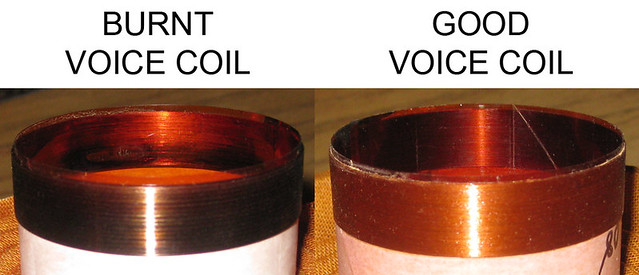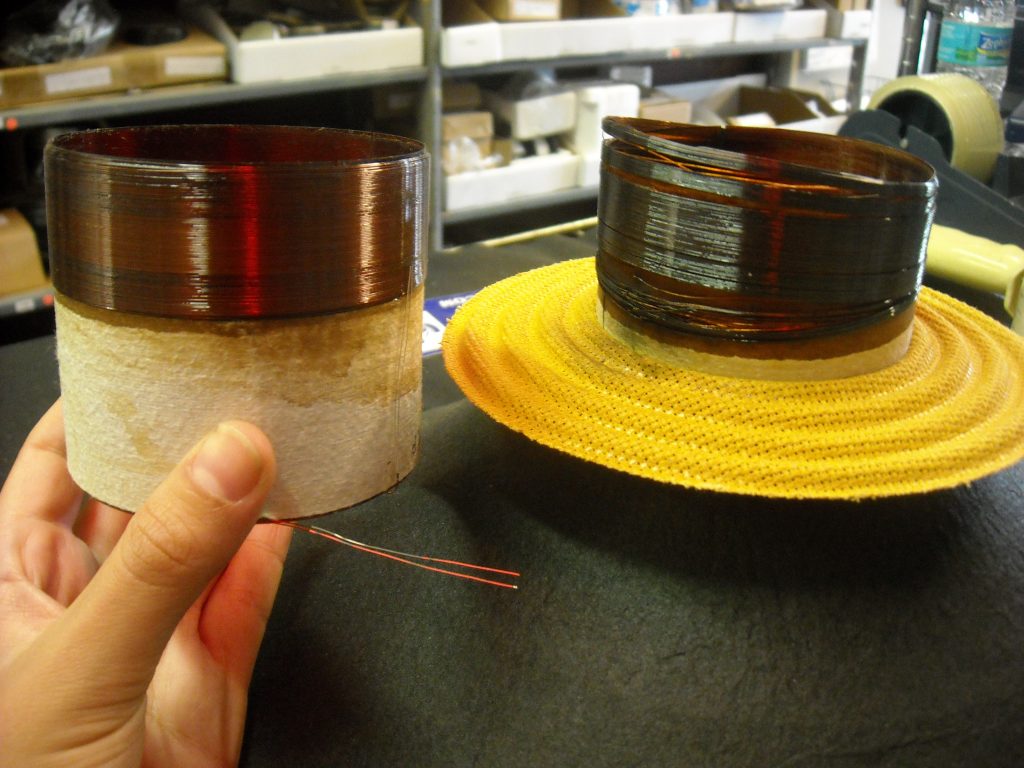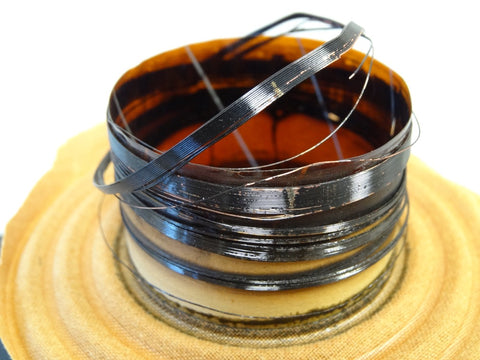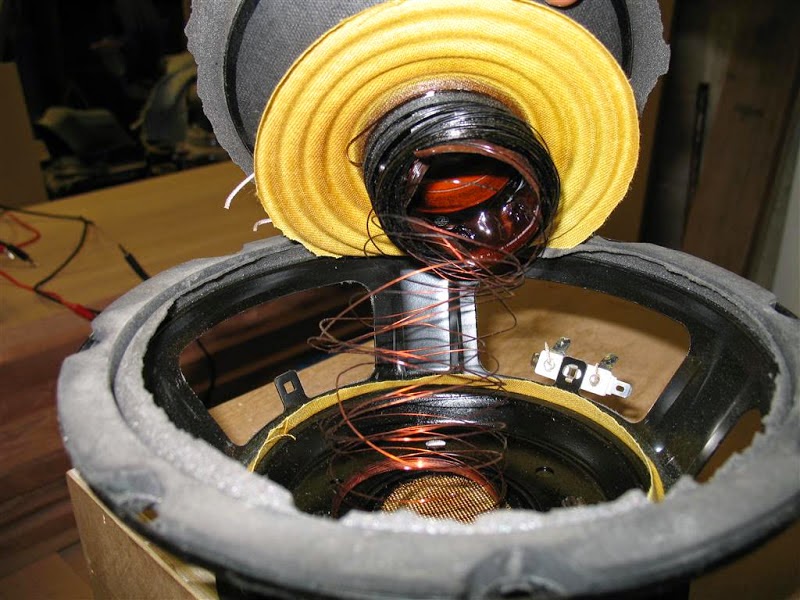People go mad and do stuff like this https://www.venhaus1.com/diycatfivecables.html
Addressing what seems to be the main question:I DO deal with blown speakers *regularly*  , since I make and repair Guitar amps (also other MI stuff) where the abuse is the norm and not the exception.
, since I make and repair Guitar amps (also other MI stuff) where the abuse is the norm and not the exception.
I have replaced, reconed, repaired hundreds of (or maybe a over a thousand) speakers so far, and have always found badly burnt wire, yet never ever found a burnt, let alone overheated connection wire, hope that answers your question.
These are typical examples, from mild (toasting) to worst (full disintegration):






I have replaced, reconed, repaired hundreds of (or maybe a over a thousand) speakers so far, and have always found badly burnt wire, yet never ever found a burnt, let alone overheated connection wire, hope that answers your question.
These are typical examples, from mild (toasting) to worst (full disintegration):


An externally hosted image should be here but it was not working when we last tested it.
An externally hosted image should be here but it was not working when we last tested it.



I have replaced, reconed, repaired hundreds of (or maybe a over a thousand) speakers so far, and have always found badly burnt wire, yet never ever found a burnt, let alone overheated connection wire, hope that answers your question.
It does. Thank you for the pictures! It seems like you had your work cut out for yourself with some of those coils..
Nice pictures - with the IR drop of coils with their thin wire, it doesn't take long for sine to smoke a coil. Re- re-coning - will an EV 15L or B kit drop into an SP15A basket ? (SP15A was the ferrite 70's driver with the whizzer cone - mine have something like a 6 ohm coil and 2 ohm series resistor to raise Qes)
That is a very broad generalisation, which is in fact quite inaccurate.Any material, close to its maximum handling, is non linear.
Be it tensile strength, vibration dampening and yes, amperage.
Wire doesn't actually have any intrinsic maximum current value. We just create arbitrary numbers in a given application we want to use it for, based on some assumptions for length, and then taking factors like heat and inductance into account.
If you ran a lot of continuous current through a speaker wire, you might make it warm up, hence increasing its DC resistance. But this is then a non-transient situation, and by then your speakers would have gone up in smoke and flames.
Sent from my phone with Tapatalk. Please excuse any typpos.
That is a very broad generalisation, which is in fact quite inaccurate.
Wire doesn't actually have any intrinsic maximum current value. We just create arbitrary numbers in a given application we want to use it for, based on some assumptions for length, and then taking factors like heat and inductance into account.
It is not a generalization. Rather an observation of how anything works in nature.
It is not unbelievable to think that between the state where a conductor is able to pass current proportionally to the electric field at its extremities and the same conductor melting there is an area of non linear behavior.
Basically the current has an asymptotic behavior with high electric fields, and if the field is applied for too long the conductor melts.
While I agree that transients are probably not long enough to make wires melt (with reasonably thick wires), that doesn't mean that the saturation is not happening instantaneously during a transient. At least this is possible under very worst case scenarios.
But, I'll give you that, these scenarios are an issue with sizes of conductors much thinner than what we are talking about, at the voltage provided by an audio amplifier.
You are talking about fuses................. to pass current proportionally to the electric field at its extremities and the same conductor melting ................if the field is applied for too long the conductor melts.
While I agree that transients are probably not long enough to make wires melt (with reasonably thick wires), that doesn't mean that the saturation is not happening instantaneously during a transient. ............
Speaker cables don't usually behave like fuses.
Usually they don't, but if you look at the pictures on post #42 you'll see that they can.
Granted, nobody uses coil wire, let alone fuse filament, as speaker wire, but conceptually there is nothing different between a fuse and a wire. It's all a matter of voltage required to make them melt.
You could see from post #7 that I have long directed my attention somewhere else, and the observation that wires can be non linear when it comes to V/A relation was more a theoretical reply to being called names by that very charming guy on post #32, not really related to our audio application, in practice.
Anyway, if one was to take anything useful out of this long, interesting but useless back and forth about current saturation, it would be that one can use a fuse in series with one leg of the wire, to protect the driver.
Any idea which fuse would be well suited for the Eikonas?
Granted, nobody uses coil wire, let alone fuse filament, as speaker wire, but conceptually there is nothing different between a fuse and a wire. It's all a matter of voltage required to make them melt.
You could see from post #7 that I have long directed my attention somewhere else, and the observation that wires can be non linear when it comes to V/A relation was more a theoretical reply to being called names by that very charming guy on post #32, not really related to our audio application, in practice.
Anyway, if one was to take anything useful out of this long, interesting but useless back and forth about current saturation, it would be that one can use a fuse in series with one leg of the wire, to protect the driver.
Any idea which fuse would be well suited for the Eikonas?
Last edited:
No, they show failed adhesive and charred enamel.
I can't see any evidence melted (fused) copper.
And they are not cables, they are pictures of failed voice coils.
There are big differences between a fuse wire and a speaker cable wrapped in insulation and enamelled voice coil windings
If you want some background information on copper wires try this:
https://en.wikipedia.org/wiki/American_wire_gauge
I can't see any evidence melted (fused) copper.
And they are not cables, they are pictures of failed voice coils.
There are big differences between a fuse wire and a speaker cable wrapped in insulation and enamelled voice coil windings
If you want some background information on copper wires try this:
https://en.wikipedia.org/wiki/American_wire_gauge
Last edited:
It's all a matter of voltage required and over how long it is applied.
Are we really debating that any metal can melt, provided enough voltage is at its ends?
What do you think would have happened if the enamel didn't burn before the metal got to heat up for longer time?
https://www.youtube.com/watch?v=MPZ2nO3EV0I
We could go on with this conversation, and split the hair mentioning that, for metal to melt, time is required and my initial question was about current saturation during transients.
However, time required is at least somewhat proportional to wire section, if not directly proportional. So we're back to the fact that it's all a matter of AWG.
We could further ask if V/I relation in a metal gets to show non linear behavior before the connection is broken by means of the metal melting.
I would say yes, since resistance is dependent on temperature.
It is all interesting stuff. Again, not really related to audio, but non the less real.
Are we really debating that any metal can melt, provided enough voltage is at its ends?
What do you think would have happened if the enamel didn't burn before the metal got to heat up for longer time?
https://www.youtube.com/watch?v=MPZ2nO3EV0I
We could go on with this conversation, and split the hair mentioning that, for metal to melt, time is required and my initial question was about current saturation during transients.
However, time required is at least somewhat proportional to wire section, if not directly proportional. So we're back to the fact that it's all a matter of AWG.
We could further ask if V/I relation in a metal gets to show non linear behavior before the connection is broken by means of the metal melting.
I would say yes, since resistance is dependent on temperature.
It is all interesting stuff. Again, not really related to audio, but non the less real.
Last edited:
He does not know about Isquared R.
That is the point.
He does not know what he is asking about.
Who?
By the way, that formula is valid for instantaneous power over a purely resistive load.
It comes from P = V*I. This is the correct formula to use to calculate power over anything, in the event that V and I are not directly proportional, which is (for the millionth time) the very unlikely instance in audio cables we are boringly debating about.
Not that it matters, because power is not what we were talking about.
Last edited:
You also need to consider the thermal capacity of the conductor, add that will determine how quickly it heats up relative to a given ohmic loss.
Anyway, you seem you have talked yourself around in a circle, and so far not established any valid reason for non-linearity in speaker connection wires used with real world amplifiers and drivers.
Sent from my phone with Tapatalk. Please excuse any typpos.
Anyway, you seem you have talked yourself around in a circle, and so far not established any valid reason for non-linearity in speaker connection wires used with real world amplifiers and drivers.
Sent from my phone with Tapatalk. Please excuse any typpos.
Anyway, you seem you have talked yourself around in a circle
That I did, yes. I have specifically said that multiple times.
and so far not established any valid reason for non-linearity in speaker connection wires used with real world amplifiers and drivers.
You need to read my previous posts. I said multiple times it has no real ground in audio applications.
So what are we talking about?
- Status
- This old topic is closed. If you want to reopen this topic, contact a moderator using the "Report Post" button.
- Home
- Loudspeakers
- Full Range
- Amperage spikes through drivers and internal wiring cable requirements